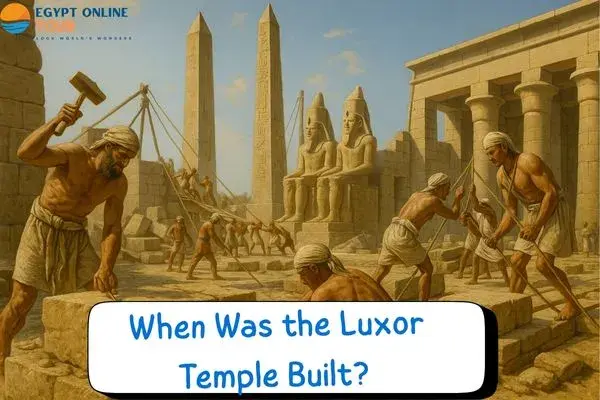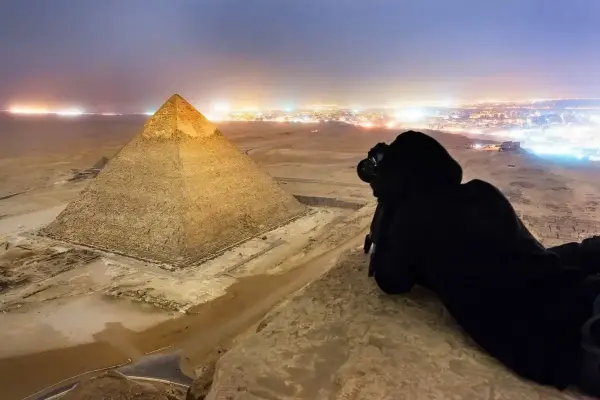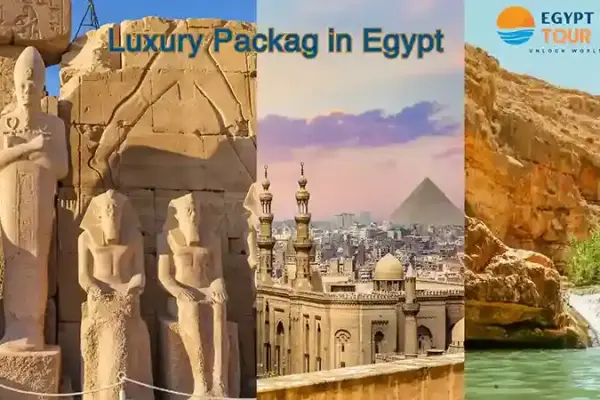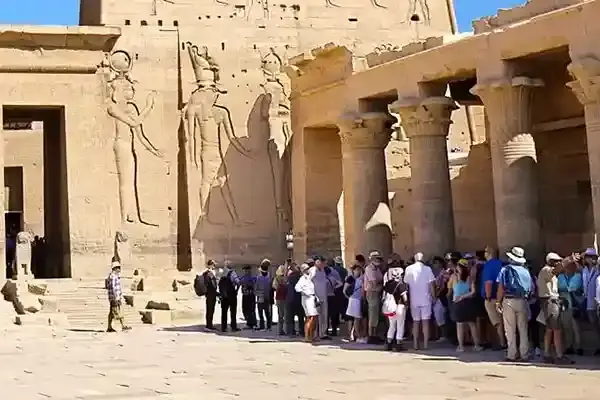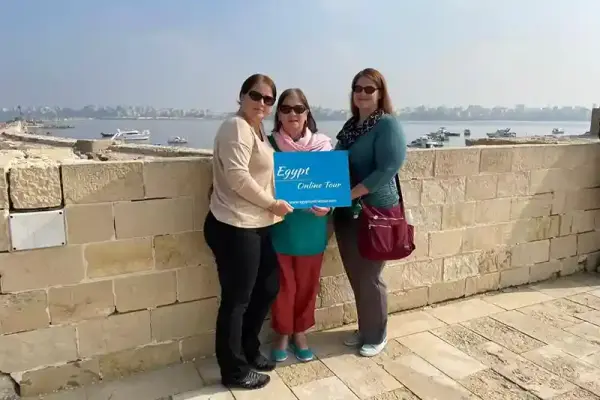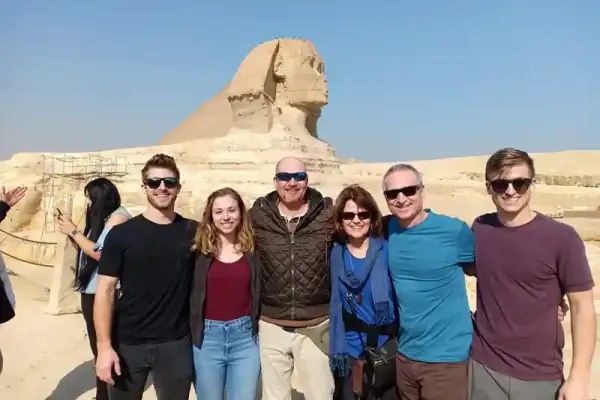Planning your Egypt adventure tour? One question often asked is “When was the Luxor Temple built?”, but the answer goes far beyond just a date. From its powerful pharaohs to its towering sandstone columns, the Luxor Temple is a masterpiece of ancient architecture. In this guide, we’ll explore its history, construction, importance, and what you’ll experience when you visit today.
Table of contents [Show]
- Where is the Luxor Temple Located?
- Who Built the Luxor Temple?
- When Was the Luxor Temple Built?
- What Is the Luxor Temple Made Out Of?
- Luxor Temple Construction: How Was the Luxor Temple Built?
- The History of the Temple of Luxor
- Why Is the Luxor Temple Important?
- Luxor Temple Facts
- How Big Is the Luxor Temple?
- How Tall Is the Luxor Temple?
- Visitor Experience at Luxor Temple
- How to Get to Luxor Temple – Getting to Luxor Temple
- Luxor Temple Today
- Conclusion
Where is the Luxor Temple Located?
The Luxor Temple is right in the heart of Luxor city in southern Egypt, Back in the day, it was called “Thebes” and was one of the most important cities of the pharaohs.
This temple was dedicated to the god Amun and played a big role in ancient festivals like the Opet Festival, if you’re planning to visit, getting there is super easy, you can walk if you're already in Luxor, or fly in or take the train if you're coming from another city.
Many Egypt tour packages include a visit to Luxor Temple, and the best part? It’s right by the Nile, so the view is absolutely stunning!
Who Built the Luxor Temple?
So, who’s the mastermind behind this massive temple? Well, it wasn’t just one pharaoh. The Luxor Temple is kinda like a group project started by one king and then added onto by others over time.
It all kicked off with Amenhotep III, a big-time king from the 18th dynasty. He was into fancy architecture and big festivals, so he built the temple to honor the god Amun and to be a key part of the annual Opet Festival. You could say he laid the foundation for what was coming next.
Then came Ramses II, the guy loved making a statement. He added the giant statues out front (yep, those huge ones are all him) and the big pylon at the entrance. Other pharaohs came later and threw in a few touches too.
So when you walk through the temple today, you’re literally walking through history with each part telling a bit of a different story from a different time.
When Was the Luxor Temple Built?
The question: "when was the Luxor Temple built?" always pops up if you plan a trip to Luxor, What most people don’t realize is that this temple's story goes way back over 3,000 years ago! It was originally built in the 14th century BC during the reign of King Amenhotep III, who started it as a tribute to the god Amun.
Later on, Ramses II, the one who loved building stuff and leaving his name everywhere, came along and added the massive gateway and those giant statues of himself you’ll see at the entrance.
And through the centuries, other pharaohs from different dynasties added their own touches too, making the temple a blend of ancient styles all in one place.
So when you visit, you're not just looking at some old stones... you're walking through a story that's been unfolding for thousands of years, and it's still standing strong today!
What Is the Luxor Temple Made Out Of?
Ever looked at the Luxor Temple and thought, “Wow, how did they even build this?” Well, the whole thing is mostly made out of sandstone, and they got it from a place called Gebel el-Silsila, which was one of the most famous stone quarries in Upper Egypt back in the day.
Sandstone from Gebel el-Silsila
Back in ancient times, the pharaohs really knew how to pick the good stuff. Gebel el-Silsila had loads of high-quality sandstone — light-colored, smooth, and super easy to carve. They’d cut those huge blocks, load them onto boats, and sail them down the Nile straight to Luxor.
So yeah, those stones you’re looking at traveled hundreds of kilometers before they even got stacked into the temple!
But it wasn’t just about the materials, it’s the way they used them. No cement, no glue, just perfectly cut stones fitted together like puzzle pieces. That’s how precise they were. Every column, statue, and carving was done with insane attention to detail.
And they didn’t just throw it all together randomly. Nope, they aligned the whole temple with the sun and stars so it would work with their religious festivals. Genius, right?
Luxor Temple Construction: How Was the Luxor Temple Built?
The Luxor Temple isn’t just some old ruins, it’s an epic story of ancient creativity and jaw-dropping engineering! What really makes it stand out isn’t just its size or the statues, but its smart design and how it evolved over time.
The construction of the Luxor Temple construction is a masterpiece that shows just how advanced the ancient Egyptians were.
Layout and Design – What’s It Like?
The temple’s layout is super organized. First thing you see? The Avenue of Sphinxes once served as a grand ceremonial route linking Luxor Temple to Karnak Temple, lined with majestic ram-headed statues that witnessed ancient religious festivals and sacred processions.
Then you step into the big open court built by Ramses II, full of giant statues of him, some standing tall, others sitting proud. Next up is the second hypostyle hall, a bit smaller, and then you head into the inner chambers, where priests did their rituals and ceremonies.
What’s cool is that the temple is built in a straight line, like a sacred path leading from the human world into the divine. Embark on our 12 Days Pyramids, Nile & Sinai Tour, exploring the architectural marvels that define Egypt's rich heritage.
How Did It Change Over Time?
Luxor Temple wasn’t built all at once…Nope, it was done in stages, as shown in the following steps:
- It all kicked off during the reign of Amenhotep III, who built the inner sanctuary and sacred rooms.
- Then Ramses II came along and added the grand courtyard and the huge entrance pylon, plus his massive statues.
- Even Alexander the Great left his mark! He carved his name into the temple when he took over Egypt.
- Later on, during the Roman era, parts of the temple turned into a church.
- And when Islam spread, a mosque—Abu Haggag Mosque—was actually built right inside the temple, and it’s still there today!
So basically, the temple has been standing for thousands of years, shaped by different civilizations, each one adding their own piece without wiping away what came before.
The History of the Temple of Luxor
The Luxor Temple isn’t just an old building, it’s one of the most iconic temples that’s still standing strong after thousands of years! It was built to be a major religious and political center in ancient Egypt, playing a huge role in both spiritual and social life back then.
Religious Role in Ancient Egypt
Luxor Temple wasn’t just for worship, it was the heart of major religious celebrations! One of the biggest was the Opet Festival. It started at Karnak Temple and ended at Luxor Temple along the Avenue of Sphinxes.
The goal? To renew the connection between the king and the god Amun, showing that the pharaoh was a legit son of the gods and rightful ruler of Egypt.
Priests performed daily rituals at the temple offering food, purifying statues, and reciting sacred chants. There were rooms just for the priests and the Holy of Holies, which held the statue of Amun. The temple was like a bridge between the people and the gods.
Transformation During the Greco-Roman Period
As time went on, and with the arrival of the Greeks and Romans, the temple went through major changes. During the Ptolemaic period, the temple was still used for religious purposes, but new elements were added—like carvings of non-Egyptian rulers. Alexander the Great even left his name engraved inside the temple!
In the Roman era, parts of the temple were converted into a church. They made some changes to match their religious practices, helping keep the site alive and in use for centuries.
Then, during the Islamic period, the Abu Haggag Mosque was built right inside the temple and it’s still there today! This shows how the place remained active and respected by different cultures and religions over time.
Read more about: How Many tombs in the Valley of the Kings
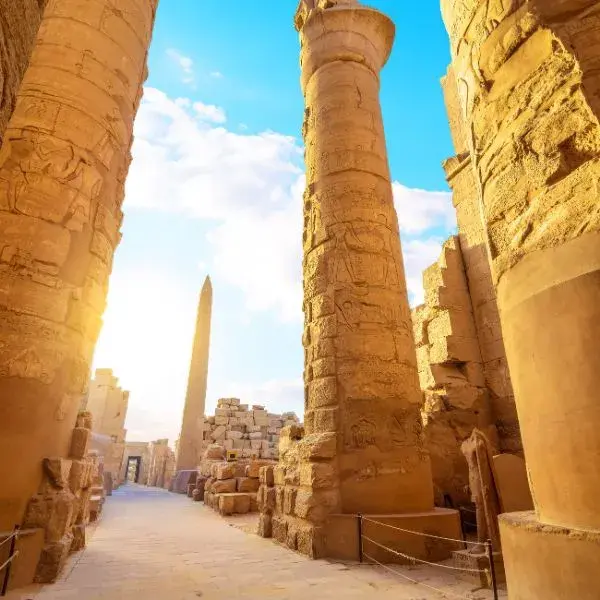
Why Is the Luxor Temple Important?
Luxor Temple isn’t just a monument, it’s a living piece of history that played a major role in ancient Egyptian religion and culture. Let’s dive into why this spot is such a big deal.
Religious Significance
This temple was a major center for worshipping the god Amun and hosted the grand Opet Festival, reinforcing the divine nature of the pharaoh’s rule, Here’s why that matters:
- It was a sacred site for ceremonies connecting pharaohs to the gods.
- The Opet Festival began in Karnak and ended here with huge celebrations.
- Priests performed powerful daily rituals in the temple chambers.
- The layout itself reflected a symbolic journey from earth to divinity.
Cultural and Historical Value
Over thousands of years, different civilizations added their mark—Pharaonic, Greek, Roman, and Islamic turning the temple into a true timeline of Egyptian history, this is important because:
- Built by Amenhotep III, expanded by Ramses II, and later touched by Alexander the Great.
- Parts of the temple were turned into a Roman church.
- The mosque of Abu Haggag still stands inside, showing how history layers over itself.
- It’s one of the must-see stops on most Egypt Adventure Tours, thanks to its deep cultural roots.
Luxor Temple Facts
Luxor Temple isn’t just a famous ancient site – it’s packed with stories and surprises that’ll totally change the way you see it! Let’s check out some fun facts and why this place is a big deal around the world.
Fun and Surprising Insights
- Believe it or not, the temple was buried under homes and mud for centuries until archaeologists started uncovering its treasures.
- There’s actually a mosque inside the temple! Abu Haggag Mosque was built right over part of the temple and is still active today, a unique mix of Pharaonic and Islamic history.
- The Avenue of Sphinxes, which links Luxor Temple to Karnak Temple, used to have over 1,000 ram-headed statues lining the path!
- Even Alexander the Great left his name carved on the temple walls, showing how important this place remained long after the Pharaohs.
- Some statues were built, destroyed, and rebuilt across different eras – one statue might actually tell multiple layers of history.
Read about: Facts about The Temple of Karnak
UNESCO World Heritage Status
Luxor Temple isn’t just famous in Egypt – it’s recognized around the globe! Since 1979, it’s been part of the UNESCO World Heritage Site list, under the Ancient Thebes area.
That means:
- The world officially acknowledges its historical and archaeological importance.
- It’s protected and maintained under international preservation efforts.
- Tourists from all over the globe visit it, and it’s always a highlight in many Egypt Adventure Tours itineraries.
- It stands as a proud symbol of Egyptian civilization that the entire world admires and learns from.
How Big Is the Luxor Temple?
The Luxor Temple isn’t just big, it’s absolutely massive! It's about 260 meters long, stretching in a straight line from the Avenue of Sphinxes all the way to the sacred sanctuary. The temple’s layout feels like you're walking a symbolic journey from the earthly world to the divine.
Discover the grandeur of ancient architecture with our 10 Days Round Trip Nile Cruise and Pyramids, showcasing Egypt's monumental treasures.
Measurements and Layout
The total length is around 260 meters, it is built along a straight axis with no sharp turns.Features include wide open courtyards, massive columns, and inner chambers for rituals. Each part of the temple was purposefully designed, reflecting layers of spiritual meaning in its architectural plan.
Luxor Temple vs Karnak Temple
Even though the Luxor Temple is huge and majestic, Karnak Temple is actually the largest in all of ancient Egypt, it’s more like a full temple city. The main difference? Unlike Karnak's intricate maze-like design, Luxor Temple follows a straightforward, linear layout that makes it easier to explore.
Combine both experiences with our 7 Day Egypt Tour Cairo Nile Cruise and Luxor Temples, offering a comprehensive exploration of Egypt's iconic temples.
How Tall Is the Luxor Temple?
The height of the Luxor Temple is just as impressive as its size. Once you stand at the entrance, you’ll instantly feel tiny! The towering statues and structures were designed to leave you speechless.
Witness these towering wonders on our 8 Days Luxury Cairo & Nile Cruise, blending opulence with ancient grandeur.
Obelisks and Colossal Statues
Ramses II statues are about 15 meters tall, Originally had two giant obelisks at the entrance, one still stands, the other now lives in Paris (Place de la Concorde).
These statues and obelisks were symbols of power and divine protection.
Temple Pillars and Pylons
Massive columns reach up to 16 meters high, especially in the open courtyards, while the main pylon (temple gate) stands over 20 meters tall, which is covered in carvings and battle scenes showing royal power.
Everything was designed to make you feel the greatness of the king and the gods. Delve into Egypt's monumental artistry with our 10-Day Egypt Nile & Alexandria Tour, showcasing the nation's most iconic structures.
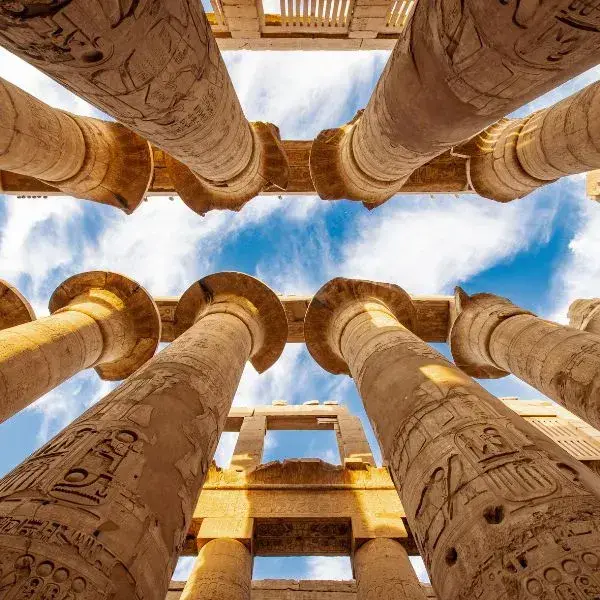
Visitor Experience at Luxor Temple
Visiting the Luxor Temple is more than just sightseeing—it’s a deeply moving experience. The moment you walk through the entrance, you’re surrounded by towering statues and massive stone walls carved with ancient tales.
The silence of the temple mixed with its majestic presence creates a feeling of awe and spiritual connection that stays with you long after you leave.
Read about: How many days in Luxor do you need to enjoy
What to Expect to see
As you walk through the temple, expect to see impressive columns, colossal statues of Ramses II, and beautifully detailed carvings that tell stories of kings, gods, and ancient rituals.
The layout of the temple guides you from the earthly realm toward the divine, making you feel like you're walking a sacred path. Every corner holds a piece of ancient magic waiting to be discovered.
Tips for Photography and Dress Code
For the best experience you should:
- wear something comfortable and respectful since the temple is still considered a sacred site.
- Bring a camera or a phone with good photo quality, because you'll want to capture the incredible details and grand views.
- Flash photography is best avoided to protect the delicate carvings.
- If you're visiting at sunset, you’ll find the lighting is perfect for stunning, natural photos.
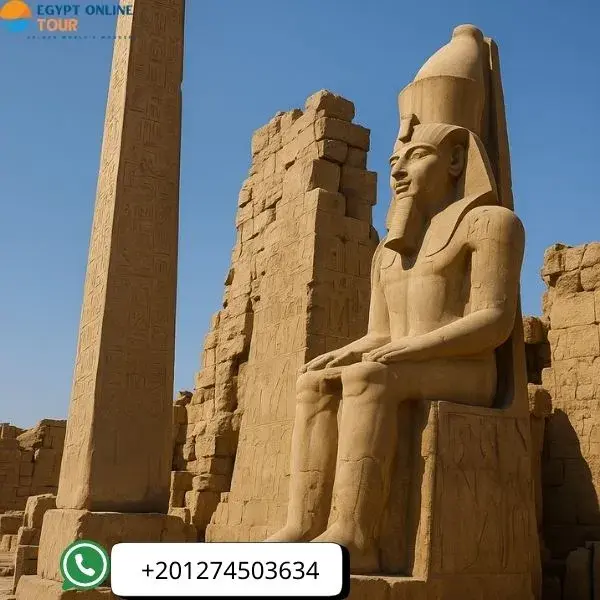
How to Get to Luxor Temple – Getting to Luxor Temple
If you’re planning to visit Luxor Temple, it’s super easy! Located in the very center of Luxor, the temple is just steps away from the city's main attractions and facilities.
- If you’re in downtown Luxor, you can easily reach it within minutes by walking, taking a tuk-tuk, or a taxi.
- If you're coming from Cairo or any other city, you can take a train or a flight and land straight into Luxor.
- From the airport or the train station, there are plenty of ways to get there easily.
The temple is not hidden at all – in fact, it’s one of the most obvious landmarks in the city, Enhance your journey with the 5 Days Cairo to Luxor Tour Packages, offering a seamless travel experience between these iconic cities.
Luxor Temple Today
Luxor Temple today is not just ancient ruins, it's a living place that blends history with everyday life! You’ll find people visiting from all over the world to witness the grandeur of the pharaohs.
What’s beautiful is that when you step inside the temple, it feels like you've stepped out of time, everything around you is calm and majestic.
The columns, carvings, and statues all tell stories from thousands of years ago.
At night, they light up the temple with amazing lights that make it look like a scene from a movie. Experience the magic firsthand with our 8 Days Cairo, Luxor, Aswan Classic Tours, immersing you in Egypt's timeless wonders.
Read about: What Is There to Do in Luxor
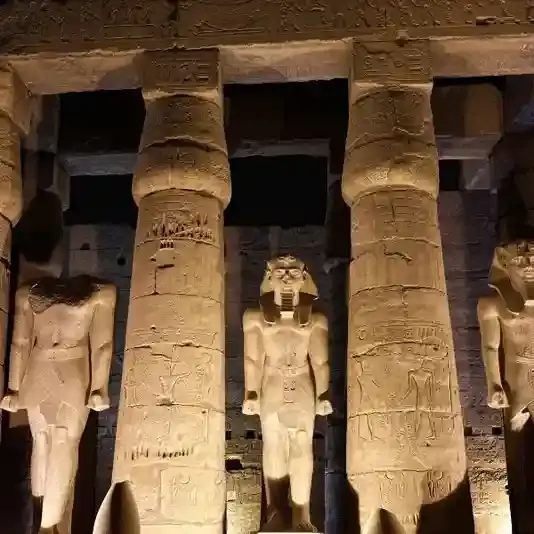
Conclusion
In the end, the Luxor Temple isn’t just an ancient monument — it’s a living experience that takes you thousands of years back to a time of kings and glory. From learning about its construction to walking between its massive columns and admiring its brilliant layout, every corner tells a story.
Whether you visit in the morning or at night, every moment there has its own magic. And if you’re planning to enjoy one of the Egypt Adventure Tours, make sure Luxor Temple is on your list — because once you stand in the middle of all that greatness, it’s a memory you’ll never forget.
Frequently Asked Questions
1 What is the oldest temple in Egypt? ▶
2 Why is the Luxor temple so famous? ▶
3 How old is the Luxor Temple? ▶
4 Are Karnak and Luxor Temple the same? ▶
5 What god is the Luxor Temple for? ▶
Popular Categories
Related properties
Cairo, Aswan, and Luxor
-
Precio
$ 2,850
-
Tipo
Package
Cairo, Aswan, and Luxor
-
Precio
$ 1,850
-
Tipo
Package
